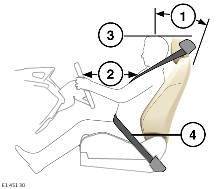
Riding with a reclined seatback increases the chance of serious or fatal injuries in the event of a collision or sudden stop. Reclining the seat greatly reduces the protection of the restraint system, i.e., the seat belts and airbags. Seat belts must be snug against the hips and chest to work properly. The more the seatback is reclined, the greater the chance of an occupant’s hips sliding under the lap section of the seat belt. The occupant’s neck could also strike the shoulder belt. Drivers and passengers should always sit well back in the seat, be properly belted, and have the seatbacks in an upright position.
Never adjust the driver’s seat while the vehicle is moving. Any sudden or unexpected movement of the seat could cause a loss of vehicle control, potentially resulting in an accident.
The seat, head restraint, seat belt, and airbags all contribute to the protection of the user. Correct use of these components gives greater protection. Therefore, always observe the following points:

Make sure that the driving position is comfortable, enabling full control of the vehicle.